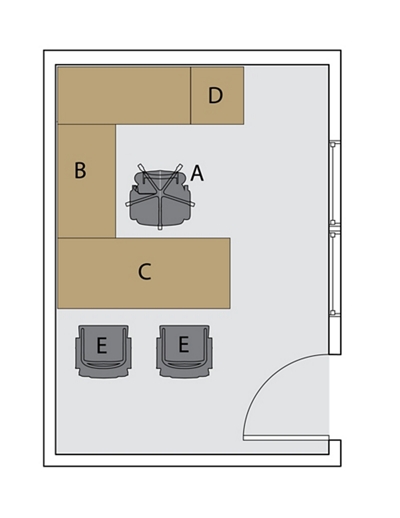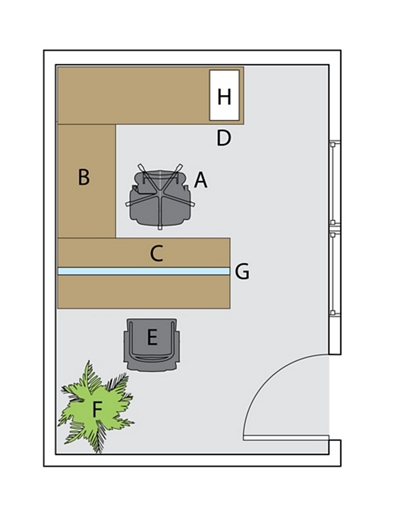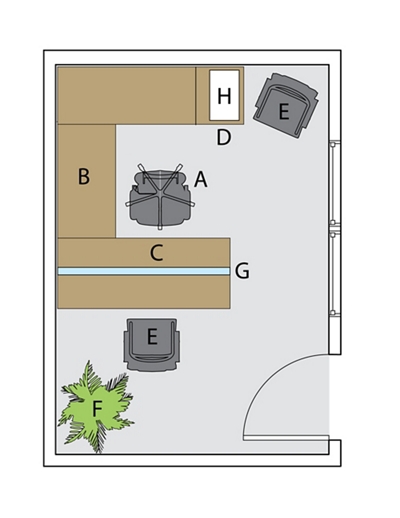As mostly independent spaces, private offices pose minimal obstacles for returning to work. Nonetheless, those who have semi-secluded spaces often need to conduct sensitive meetings with clients, coworkers, direct reports, and more. Careful improvements can maintain the usability of these spaces in a safe, sanitary, and thoughtful manner.
Whether you're retrofitting, renovating, or reinventing your office space, NBF has the tools you need to make a safe return to work. Contact us at 800-558-1010 for details about our complimentary space planning and design services.
A Desk Chair
B Workspace
C Meeting Space
D Storage
E Guest Chair
F Artificial Plant
G Acrylic Divider
H Cleaning Supplies
BEFORE
- In addition to dedicated workspace, some of the desktop is used for meetings with 1-2 guest chairs across from the executive chair
- A larger private office may feature a separate small meeting table with 2 to 4 chairs
IMMEDIATE CHANGES
- Restrict occupancy to 2 people in the office at maximum
- Physically remove excess guest chairs
- Add a clear acrylic divider down the middle of the meeting space for physical separation
- Provide cleaning supplies for wiping down personal surfaces, meeting surfaces, and door knobs
- Provide hand sanitizer for both personal and guest use
LONG-TERM SOLUTION
- Maintain physical barriers across meeting spaces
- Reintroduce a second guest chair in an out-of-the-way area
- Continue using cleaning supplies and personal sanitizers
- Use artificial plants to discourage the use of guest chairs in restricted areas
LEARN MORE ABOUT THE ALL-NEW OFFICE
The Complete Guide to Furniture Cleaning
Here at NBF, we're serious about keeping things clean around the office. So much so that we've written about it fairly extensively over the years. Now, let's look at some of the most common office furniture materials and how to keep them squeaky clean.
Of course, not all materials can stand up to all solvents. Consult your manufacturer to see if they have specific recommendations for general maintenance, deep cleaning, and disinfecting. New cleaning agents and solvents enter the market constantly, making it more important to be aware of what chemicals do and don't work on different items.
For immediate sanitization and to prevent the further spread of germs, occasional and sporadic use of disinfectants is OK. Don't rely on cleaning wipes or disinfectant sprays as a substitute for routine or deep cleaning, but as a matter of public safety, furniture should always be designed to withstand occasional use.
Solid Surfaces
For desks, file storage, bookcases, and other office mainstays, only a few materials can provide a stylish look that stands up to regular use. Most office furniture is constructed from durable scratch and stain-resistant laminate or veneers that mimic the natural appeal of solid wood. Both materials have their benefits but caring for each material differs dramatically.
Other furniture, such as reception seating or anything in a healthcare setting, will often feature durable materials that can handle more rigorous solvents. These pieces are designed for environments with high levels of human contact or spaces prone to messes and other hazards.
Laminate
Laminate finishes have come a long way over the years. These days, laminate desks are often more popular than their wood or veneer counterparts, thanks to their durability. This finish boasts resistance to heat, scratches, and stains, making it just right for high-traffic areas, spaces that encounter rigorous wear and tear, or offices that need furniture that's built to last.
Warm, soapy water is preferred for cleaning laminate surfaces. Mix a few drops of dish detergent into a bucket of water and go to town. While this almost sounds too easy to be true, laminate is naturally less porous than natural surfaces, making it vital to take care of germs and buildup on the surface. Always rinse with clean water after scrubbing, ensuring that there's no soap residue after cleaning.
Avoid abrasive chemicals, especially bleach and ammonia-based cleaners or those with any sort of grit. These aggressive solvents can change the color of your finish, dulling it with repeated cleanings. While it's the most resilient of furniture finishes, long-term maintenance will help your furniture look great for much longer.
See more details on laminate care here.
Wood Veneer
Veneers combine the many brilliant attributes of both man-made and natural surfaces. These pieces are finished with an extremely thin layer of real wood bonded to a lighter, less expensive wood or manufactured board. This creates furniture with all the natural beauty of solid wood yet is easier to move and costs significantly less overall. Like most natural materials, veneers are easier to damage and require a higher level of maintenance than their laminate counterparts.
It's key to be gentle with wood veneer. Use a microfiber or cotton cloth and, if necessary, highly-diluted mild, soapy water for everyday cleaning. It's tempting to use aerosol furniture polish with its high shine and lovely smell, but these oil- and wax-based cleaners leave harmful residue and buildup on surfaces. As with laminate, avoid harsh cleaners, such as bleach or ammonia, at all costs.
With veneers, the best defense is a good offense. Actively care for your veneer furniture by dusting routinely, actively managing scuffs and scratches with polish, and always using coasters for drinks and mats for hot food. Combined with effective cleaning, this will keep your veneer furniture looking great for years to come.
See more details on wood veneer care here.
Plastics and Man-Made
Not all plastic and plastic-like materials are the same. Manufactured surfaces have differing degrees of porousness and cleanability. In the office or home, it's safe to rely on soap and water as you would with laminate or veneers. You could also use a diluted vinegar mixture for regular washing. Plastics are typically more resilient to common disinfectants and household cleaners, making it easy to use bottled solutions or wipes for a quick cleanup.
Healthcare environments follow a completely different set of rules and regulations when it comes to their man-made materials. The wide variety of materials available, as well as the degrees of solvents used, vary dramatically. In most situations, contact your manufacturer to make sure that your surfaces can be used with the required cleaning agents.
Metal
While its use isn't as common in office environments, some furniture pieces are made from powder-coated metal, stainless steel, aluminum, and chrome-plated elements. While these are often accents or only part of the construction, they still require cleaning and care along the way. Most metal surfaces can be cleaned with the same simple dish detergent and water combination mentioned above, but some have a few more requirements:
-
Powder coating should never be cleaned with any abrasive cleaning agents or sponges, as this can very easily damage the coating.
-
Chrome plating will easily show scuffs and scratches, lending itself to nonabrasive cleaners and sponges. Be sure to thoroughly dry the finish to prevent watermarks, and use a clean microfiber cloth (without any additives) in circular motions to bring to a polish.
-
Brushed aluminum and stainless steel can be easily cleaned with a simple solution of vinegar and water and, as with chrome, should be dried thoroughly to prevent water spots.
-
Copper, brass, and other decorative metals are often used as hardware or small accents and can usually be cleaned with the same nonabrasive solvents used to clean laminate or wood veneers.
Upholstery
Not all materials are created equal, and that's especially true when evaluating upholstery types. When purchasing furniture, you probably made upholstery decisions based on several factors—durability, cleanability, and style—with varying degrees of quality for each type of upholstery.
There have also been major changes in technology and coatings for all types of upholstery. Especially within the world of fabrics, new coatings and treatments have made specialty textiles available for healthcare environments that would otherwise require a less porous solution. As always, consult the manufacturer to confirm the capabilities of your chosen material. Material care tags will provide the most specific and accurate information for furniture care.
Fabric
Just as you would dust a solid surface, it's wise to always start with vacuuming your seating with a hose or upholstery cleaning attachment to ensure that crumbs, dirt, and other debris won't get in the way of cleaning. Outside of professional deep cleaning, fabric requires minimal day-to-day cleaning beyond vacuuming consistently and wiping down with a mild solution on a damp towel.
You should clean deeper stains immediately. If you don't know the trick for a specific type of stain, start with the basics and work your way up. Begin with a towel or sponge and plain water, using a dabbing (never dragging) motion to soak up as much of the stain as possible. Next, add a bit of dish detergent and continue to dab. For more stubborn stains, move on to a stronger vinegar or alcohol solution and continue to dab. Despite the harsh scent, these usually dissipate after a while, though the area should still be finished with a pat of plain water.
If you're still not seeing the results you want, hit the closet or the laundry room for stain-specific solvents that can get tougher or older blemishes out of your fabric. As best you can, try to patch test these items on an out-of-sight area to ensure they won't rapidly fade the fabric. Avoid bleach at all costs, as it can leave white marks or degrade the fabric quickly.
Mesh
Mesh office chairs offer cooling breathability that's great for stuffy office environments. As a bonus, they're easy to care for. The mesh fibers are usually made from a more durable synthetic material that's highly resistant to staining as long as you clean it regularly. From time to time, vacuum up crumbs and dirt as part of your regular cleaning schedule and run a damp cloth over the mesh to remove any buildup.
Mesh chairs often come with a seat upholstered in a different material, such as fabric, polyurethane, or even leather. Make sure you're using the appropriate cleaning materials on all parts of the chair.
Polyurethane
Often called faux leather when referring to office chairs, polyurethane is a popular choice if you want a fabric that looks great, can mimic any number of textures and is incredibly easy to clean. From your stately executive chair to guest rooms everywhere, a polyurethane alternative can be a stylish alternative to fabrics or more durable (and expensive) materials.
As always, the best easy clean comes from a light soapy mixture on a damp cloth. Along with your other surfaces, dish soap works just fine. Since it's synthetic, you can also rely on other household cleaners, such as a vinegar solution, to clean crevices or creases that catch extra buildup.
While these are great for high-traffic office, reception, and some hospitality environments, there's a degree of porousness that's not well-suited for healthcare or some food service areas that require deeper cleaning due to more hazardous materials.
Vinyl
Not only is vinyl the most durable option, but it's often cost-effective as well. Vinyl comes in a variety of styles and grades to suit a variety of environments. When selecting furniture, be aware of your requirements while selecting an upholstery. Especially when shopping for healthcare furniture, select a vinyl that's designed to stand up to the solvents required for your specialty or institution. Differences in durability can match your needs.
Because of its inherent toughness, you can clean vinyl with any number of solvents. For nonhealthcare environments, choose what best matches your industry. Be sure to wipe down your furniture to eliminate dust and debris before cleaning with a damp cloth and whichever cleaner you choose. After, rinse your vinyl with plain water to remove any excess solvent to ensure your upholstery lasts as long as possible.
See more details about cleaning healthcare furniture here.
Leather
Luxury comes with a price. Leather furniture can be appealing, but it also comes with higher maintenance needs and more complicated processes. Along with that, the higher the grade of leather, the more rigorous your care needs to be. No matter what, use a leather conditioner every so often to provide deeper nourishment between cleanings.
Because of its specific needs, premade leather cleaners contain the necessary cleaning compounds and hydrating compounds to take care of day-to-day care. Patch test the cleaner first and simply spray them on and wipe them off regularly.
For a more home-grown solution, use one part vinegar and two parts linseed oil to form a highly effective cleaning compound. This takes a bit of time, so rub the mixture onto your chair and let it sit until dry, usually over a few hours, before using a clean cloth to rub it in and reach a high shine.
As for stains, use a cotton ball dipped in alcohol in dabbing or circular motions until the stain fades, then be sure to apply leather conditioner so the area doesn't become dried out or cracked from the harsh alcohol solution. Ideally, patch test an out-of-the-way area to ensure the fading isn't too intense. If the stain isn't too deep, begin with a less diluted vinegar solution to see if this gentler method is effective.
See more details on cleaning leather upholstery.




